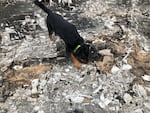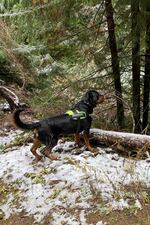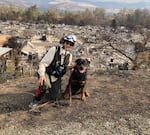
Vali is a 7-year-old Rottweiler trained in identifying the scent of human decomposition.
Courtesy of Sharon Ward
A dog’s nose is very sensitive.
According to Sharon Ward, a training officer with Pacific Crest Search Dogs, while humans have 10 million receptors for odor, dogs have 250 million.
“We, for example, smell a chocolate chip cookie,” Ward said. “A dog smells the vanilla, the flour, the chocolate chips, the butter. It smells all of the components where we generalize.”
This is what makes dogs perfect for sniffing out substances and helping authorities track down missing persons. But that isn’t what Ward uses a canine’s incredible receptors for.
She uses them to find human remains.
Ward has been a dog trainer since the 1990s and aids local authorities throughout the Pacific Northwest when they need help. Earlier this month, Jackson County Sheriff’s office used Human Remain Detection dogs, similar to the ones Ward trains, when skeletal remains were found at the Roxy Ann Peak Trail.
Training begins as early as 8 weeks. It involves introducing scent tubes and rewarding puppies, typically with a hot dog, when they put their snout to the tube. Trainers will eventually introduce more tubes with different odors until they continue to sniff out what the trainers are trying to reinforce.

A dog's sense of smell allows them to detect the odor of 600 elements of human decomposition.
Courtesy of Sharon Ward
The hard part is getting human remains to aid in training. Ward says it’s vital to get real remains as there are over 600 different elements of human decomposition odors dogs need to sniff out.
She says that sometimes to get the right tools to train a dog, you have to ask a friend.
“If you cut yourself,” she said, “I might help you with a gauze pad and then take that gauze pad and use it as a training article for blood.”
Ward has gotten hip and knee bones after friends’ surgeries, remains from mastectomies, placentas and even teeth. This let’s a dog understand what human remains smell like compared to others.
In fact, Ward has worked with dogs on wildfire scenes and noted they are able to point out human cremains amongst the ashes of homes and buildings.
“A dog can tell the difference between human cremains and dog cremains. That dazzled me.” She said.
Some of the biggest challenges that come in her line of work is when wildlife is involved. She says big scavengers like bears and cougars will take whatever they want from a body and then are followed by smaller critters like coyotes and mice. They’re lucky when they are able to find pieces of pelvis among the scraps leftover.
“There’s just not very much to find if you’re in that type of area with a lot of scavengers. Nature is very efficient.”

Sharon Ward has been training Human Remains Detection dogs since the 90s, she's used her dogs to find remains at wildfires, mudslides and missing persons cases.
Courtesy of Sharon Ward
While working with Human Remain Detection dogs is centered around death, Ward says the work is rewarding in some ways.
“This person is deceased but at least the family now has closure.” She said, “They can begin their grieving process because they know what happened. They know the person’s not coming back.”
To hear more from Think Out Loud’s conversation with Sharon Ward, including a story about Human Remain Detection Dogs, click the “play” button at the top of the page.
